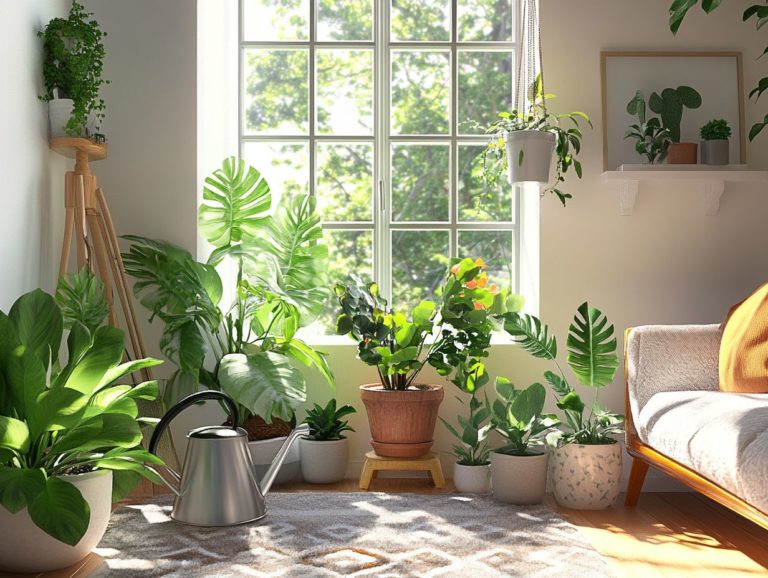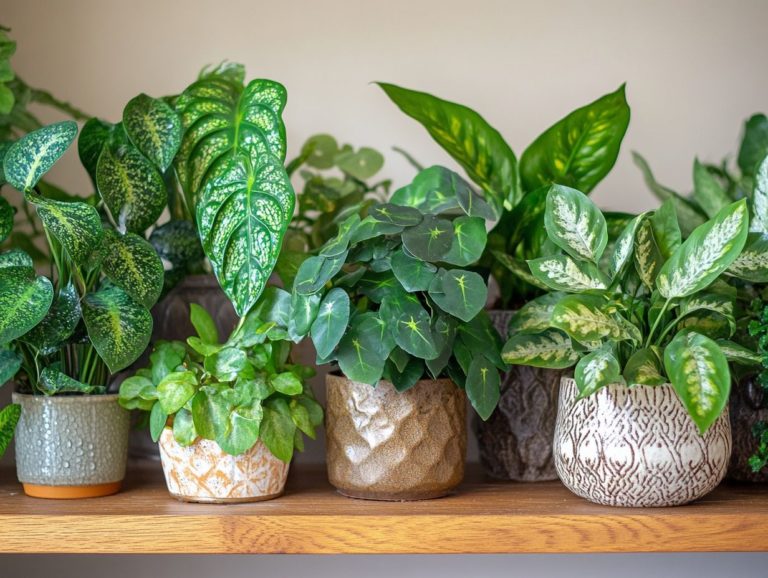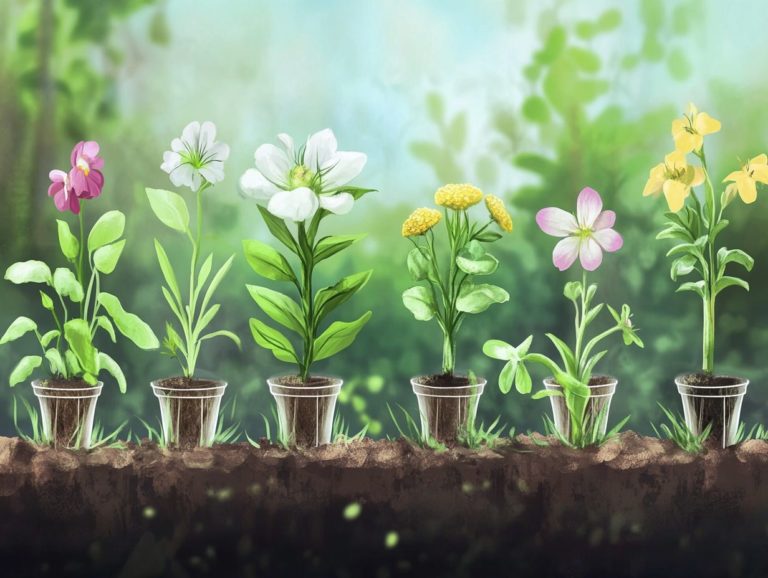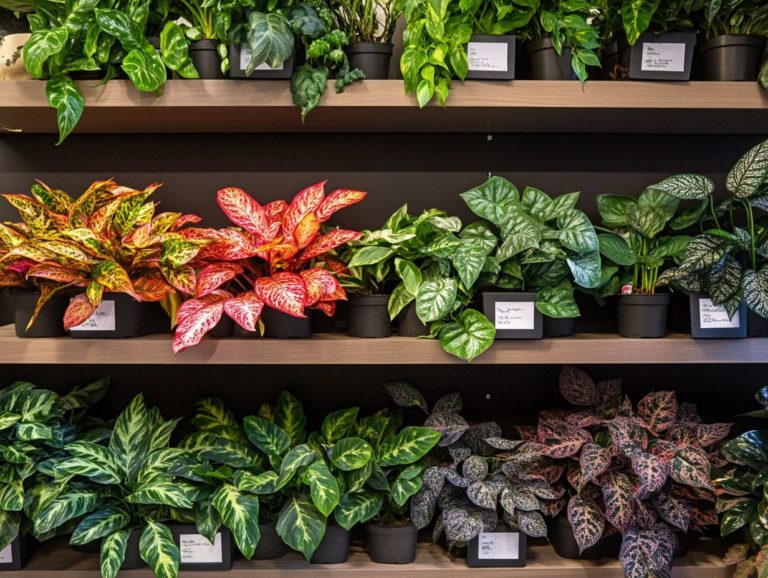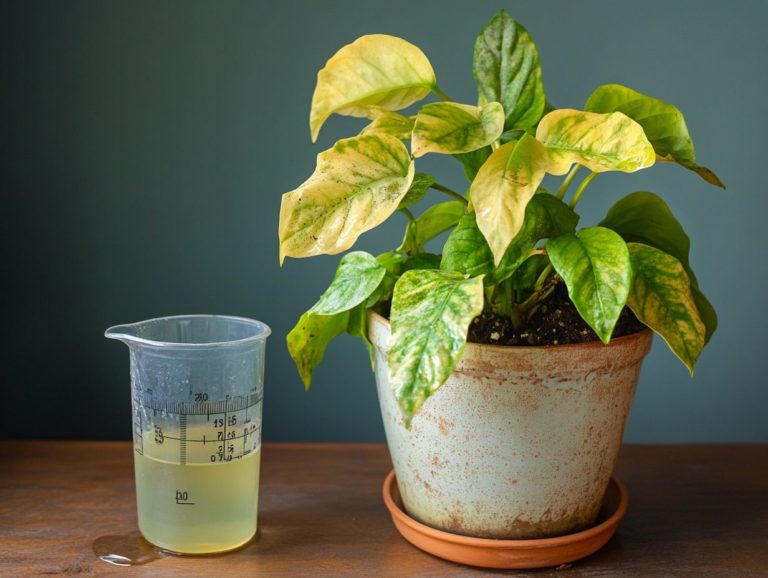How to Choose Indoor Plants for Low Light?
Low light environments are common in homes and offices. However, you can still enjoy the beauty of indoor plants.
It’s important to know what causes low light and how certain houseplants thrive in these conditions. This knowledge enhances air quality and lifts your mood.
Discover the amazing benefits of low light plants that can brighten your home! This guide highlights the best options and shares essential care tips to keep your indoor oasis vibrant.
Whether you’re an experienced gardener or just starting out, you’ll find practical insights to help you grow a lively space, even in dim corners.
Contents
- Key Takeaways:
- Understanding Low Light Environments
- Benefits of Indoor Plants in Low Light
- Types of Indoor Plants for Low Light
- Factors to Consider When Choosing Plants
- Tips for Caring for Low Light Plants
- Creating a Low Light Plant Environment
- Frequently Asked Questions
- What are some factors to consider when choosing indoor plants for low light?
- What are some common types of low light indoor plants?
- How can I determine the lighting conditions in my home?
- What are some low light plants that are safe for pets?
- Do all low light plants require the same amount of maintenance?
- Can I use artificial light to supplement low light for indoor plants?
Key Takeaways:
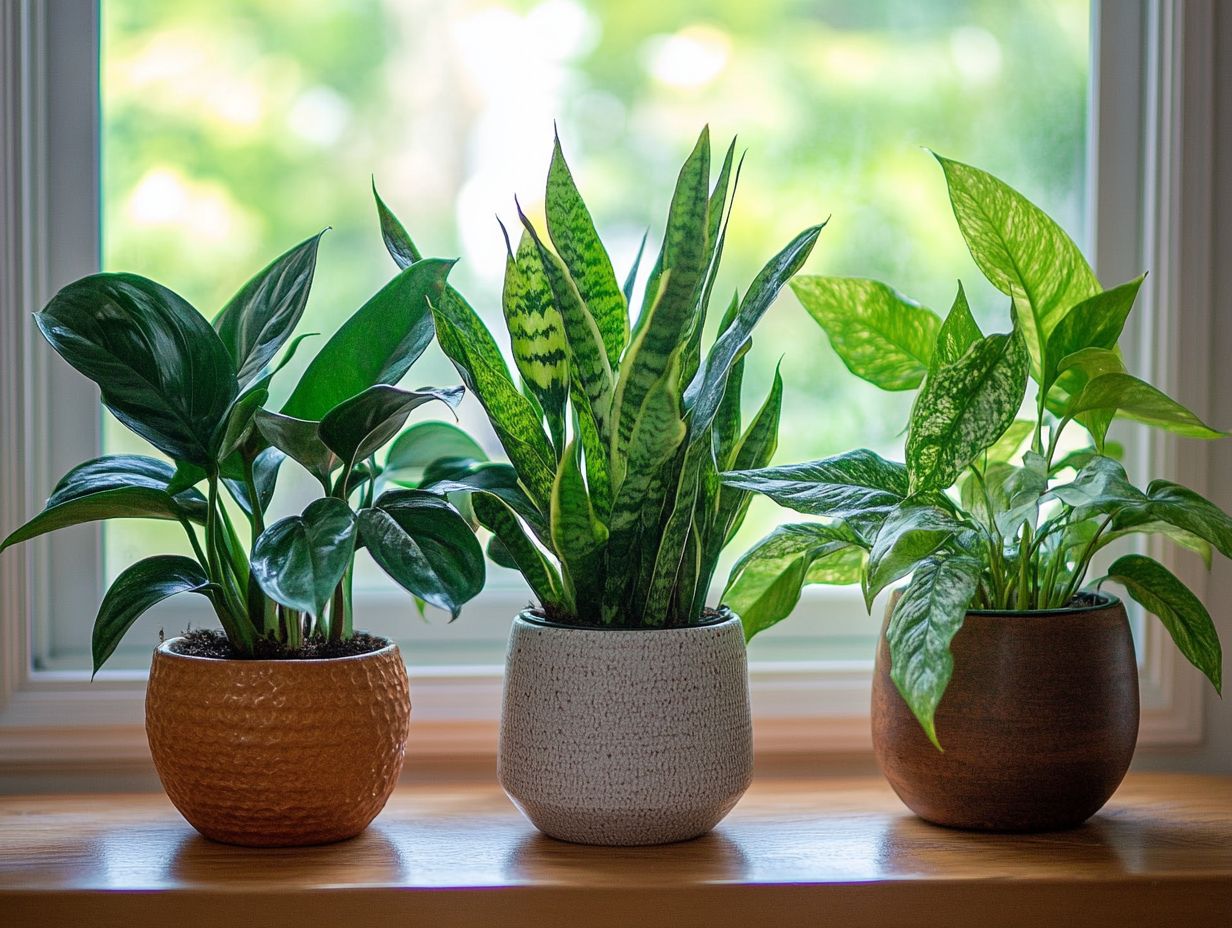
Understanding Low Light Environments
Understanding low light environments is key for indoor gardeners. You can nurture low light houseplants that flourish indoors without worry.
Elements like window placement and room arrangement greatly affect how your plants adapt. Knowing the challenges and advantages of low light helps you make better plant choices.
Factors that Contribute to Low Light
Several factors create low light conditions. It’s essential to know how these elements affect your houseplants’ growth.
One important factor is window placement. Small or north-facing windows may not provide enough natural light for your plants.
Large buildings or trees nearby can also block sunlight. These shadows restrict light for your indoor garden.
Your home decor matters too. Dark wall colors or heavy curtains can absorb light instead of reflecting it, complicating growing conditions for your plants.
These factors impact not just the health of your low-light plants, but also their appearance. If you want your plants to look vibrant, you’ll need to consider these aspects.
Benefits of Indoor Plants in Low Light
Indoor plants provide numerous benefits, even in low light. They enhance your space’s beauty and improve air quality, boosting your mood.
By choosing the right varieties, you can create a calming indoor oasis. Adding expert-recommended plants, known for their air-purifying qualities, will help filter out toxins.
With the right gardening tips, you can thrive, even when natural light is scarce.
Improving Air Quality and Mood
Air-purifying plants enhance both air quality and your overall mood. They are perfect companions for your indoor gardening endeavors, especially in low-light settings.
These plants filter out harmful pollutants and create a calm space, encouraging relaxation and mental clarity. Gardening experts recommend resilient species like snake plants and peace lilies, known for their low-maintenance nature and impressive air-cleaning capabilities. For those with limited natural light, exploring the top 10 indoor plants for artificial light can be especially beneficial.
For instance, one gardening expert noted that bringing these air-purifying plants into your space significantly uplifts your emotional well-being. They offer tranquility and elevate the plant aesthetics of any room. By incorporating these top indoor plants for varied lighting into your home, you foster a sense of mindfulness, inviting connection with your green companions and appreciating the beauty of nature within your living space.
Types of Indoor Plants for Low Light
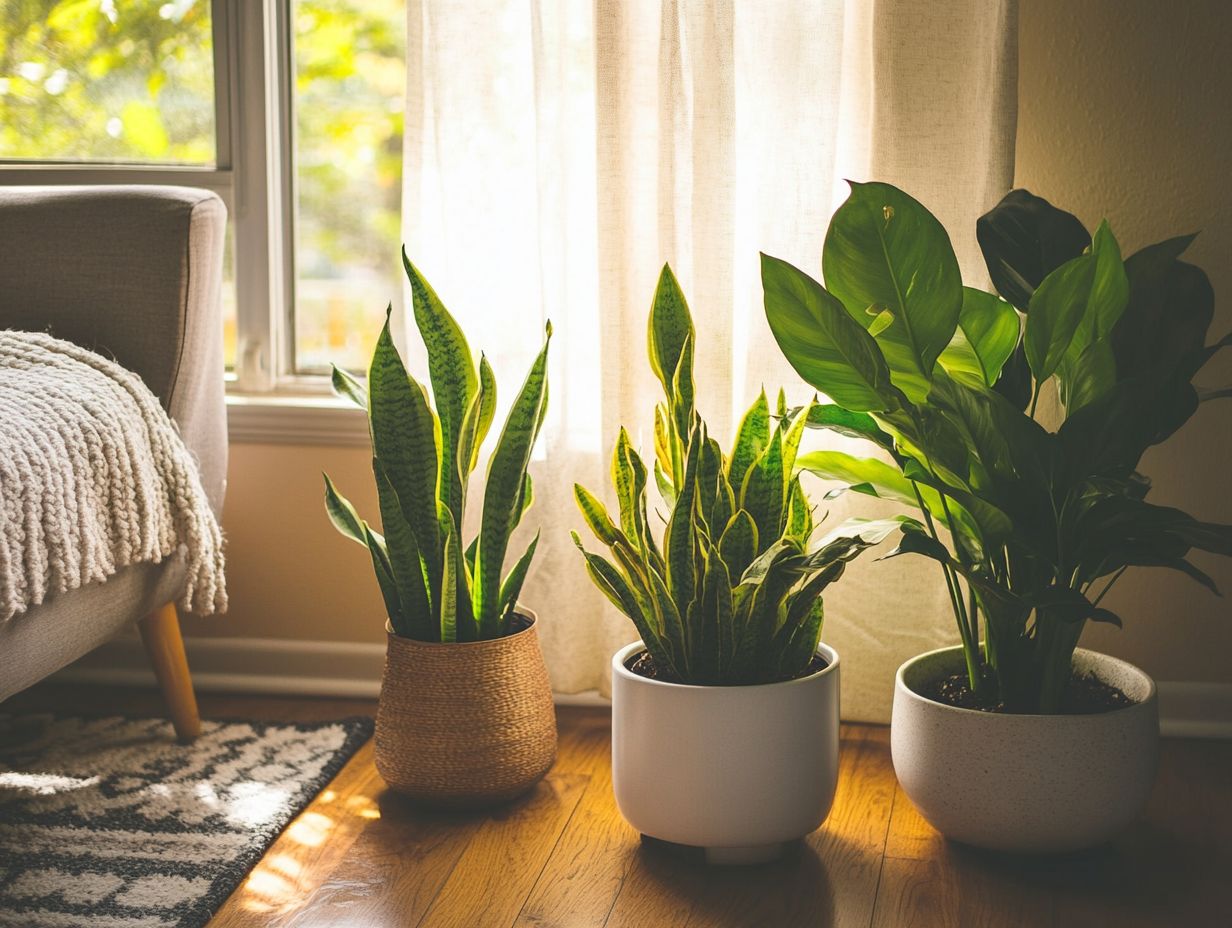
When considering indoor plants that thrive in low light conditions, you ll find many easy options. These selections can beautifully enhance your indoor space while requiring minimal effort to care for them.
Common Varieties and Characteristics
Common easy indoor plants, such as Dracaena, Philodendron, Zamioculcas, and Aspidistra, are renowned for their resilience and ability to thrive in low-light conditions.
Each species brings its own unique charm. The Dracaena has striking upright foliage, making it an excellent space saver. The Philodendron, with its trailing growth, is perfect for hanging baskets and shelves, requiring minimal sunlight and infrequent watering. To choose the right plants for your space, consider the indoor light levels and plant selection.
The Zamioculcas, known as the ZZ plant, is incredibly drought-tolerant and flourishes even with neglect. It adds a glossy touch to any room. The Aspidistra, affectionately called the cast iron plant, showcases remarkable durability, ideal for beginners or those with busy lifestyles.
These plants not only beautify your space but also improve air quality, making them essential companions for any low-light area.
Factors to Consider When Choosing Plants
When selecting plants for your indoor garden, particularly in low light, consider several factors.
Check the light requirements of each plant and assess the level of maintenance you re prepared to provide. This thoughtful approach enhances your chances of creating a thriving indoor garden.
Light Requirements and Maintenance
Understanding light requirements and maintenance is crucial for helping your plants flourish, especially low-light varieties.
By assessing the amount and quality of light in different areas of your space, you can boost the growth and health of your indoor plants. Observing natural light shifts throughout the day helps you strategically place your plants, ensuring they receive adequate sunlight while avoiding harsh afternoon rays that could harm their delicate leaves. For more detailed guidance, check out our resource on understanding indoor plant light needs.
Incorporating regular maintenance tasks, such as rotating your plants for even light exposure and cleaning their leaves to enhance photosynthesis, is key to promoting their vitality. Additionally, using light shades for indoor plants can help filter light effectively. These simple gardening tips create a flourishing environment, transforming your space into a lush, healthy indoor garden.
Tips for Caring for Low Light Plants
Caring for low light plants requires a tailored approach. Implement precise watering techniques, well-timed fertilizing schedules, and thoughtful pruning methods to ensure your houseplants thrive. These practices are essential to promoting their health and longevity.
Start your indoor garden today and transform your space into a lush oasis!
Watering, Fertilizing, and Pruning
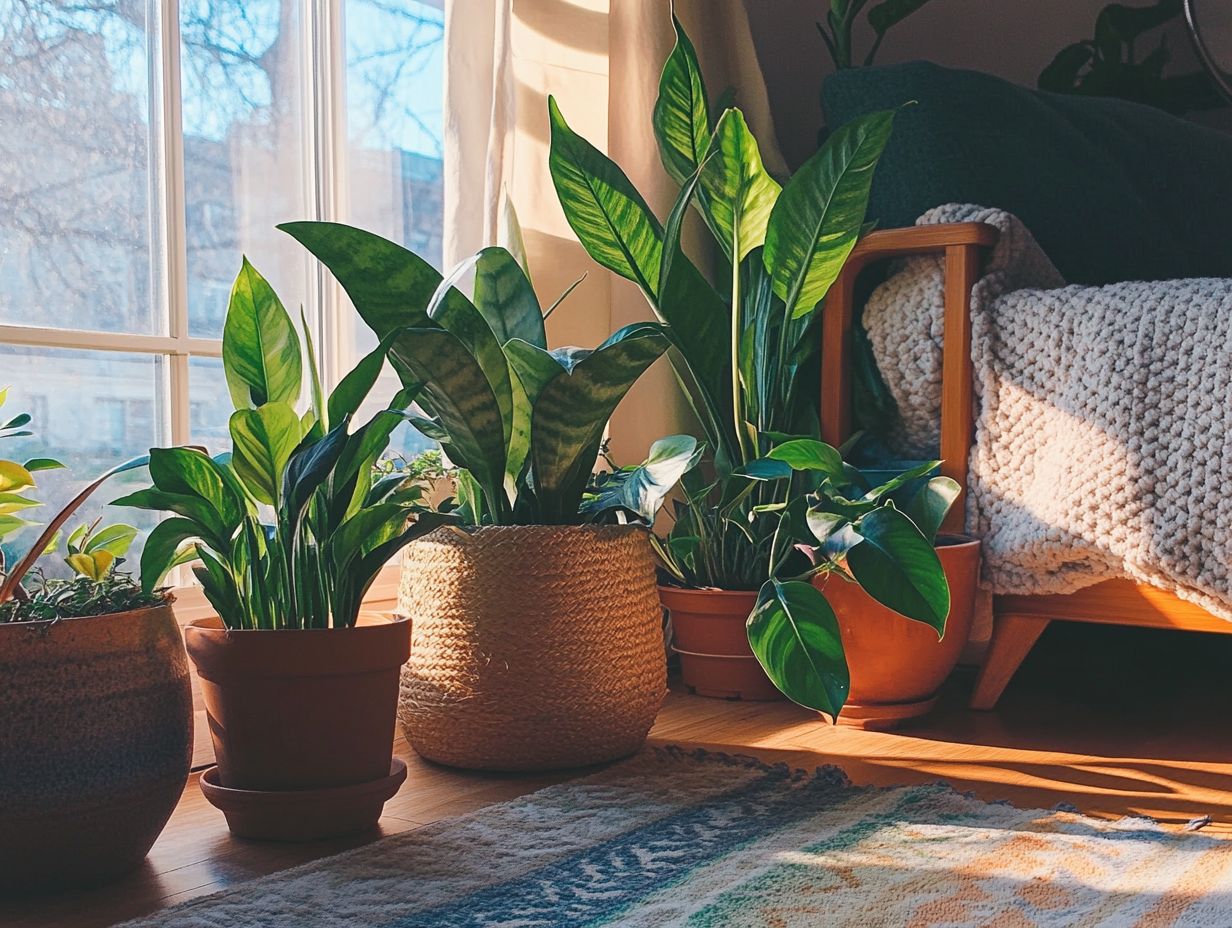
Watering, fertilizing, and pruning are fundamental practices in plant care that can profoundly impact the health of your easy indoor plants, especially in low-light environments.
These techniques ensure your plants not only survive but also exhibit vibrant foliage and robust growth. For those looking to enhance their indoor space, selecting Indoor Plants That Thrive in Low Light can make a significant difference. In low light, figuring out how much water your plants need is crucial; they may require less frequent watering as their growth slows down. For optimal fertilization, applying a diluted liquid fertilizer during the growing season helps support healthy development without overwhelming your plants.
Regular pruning not only eliminates dead leaves but also encourages healthier plants that grow more leaves. This is especially beneficial in dim spaces where houseplants stretch toward light. By thoughtfully adapting these strategies and incorporating low light indoor plants, you can cultivate a thriving indoor garden that flourishes even in challenging light conditions.
Creating a Low Light Plant Environment
Creating a low-light plant environment involves thoughtful choices in design and placement. It’s about making your space look good while also meeting the needs of your indoor plants.
Consider how each element in the space can enhance both beauty and functionality, ensuring your green companions thrive in their new home.
Design and Placement Considerations
Design and placement are vital for effectively showcasing your houseplants, especially in low light.
The arrangement of your furniture can significantly impact the balance between looks good and functionality. For example, positioning plant stands or pedestals strategically can elevate your greenery, allowing it to capture any available natural light while enhancing the visual appeal of the room.
You can also add mirrors to reflect light and brighten the space, creating a more vibrant atmosphere. This integration ensures your plants thrive and become focal points that enhance the overall ambiance, contributing to both tranquility and beauty in your home.
Frequently Asked Questions
By understanding plant care and selecting expert-recommended plants, you’ll be better equipped to create a thriving indoor garden.
What are some factors to consider when choosing indoor plants for low light?
When choosing indoor plants for low light, consider the natural light in the room, the plant’s water and nutrient needs, and the level of maintenance you’re willing to provide.
What are some common types of low light indoor plants?
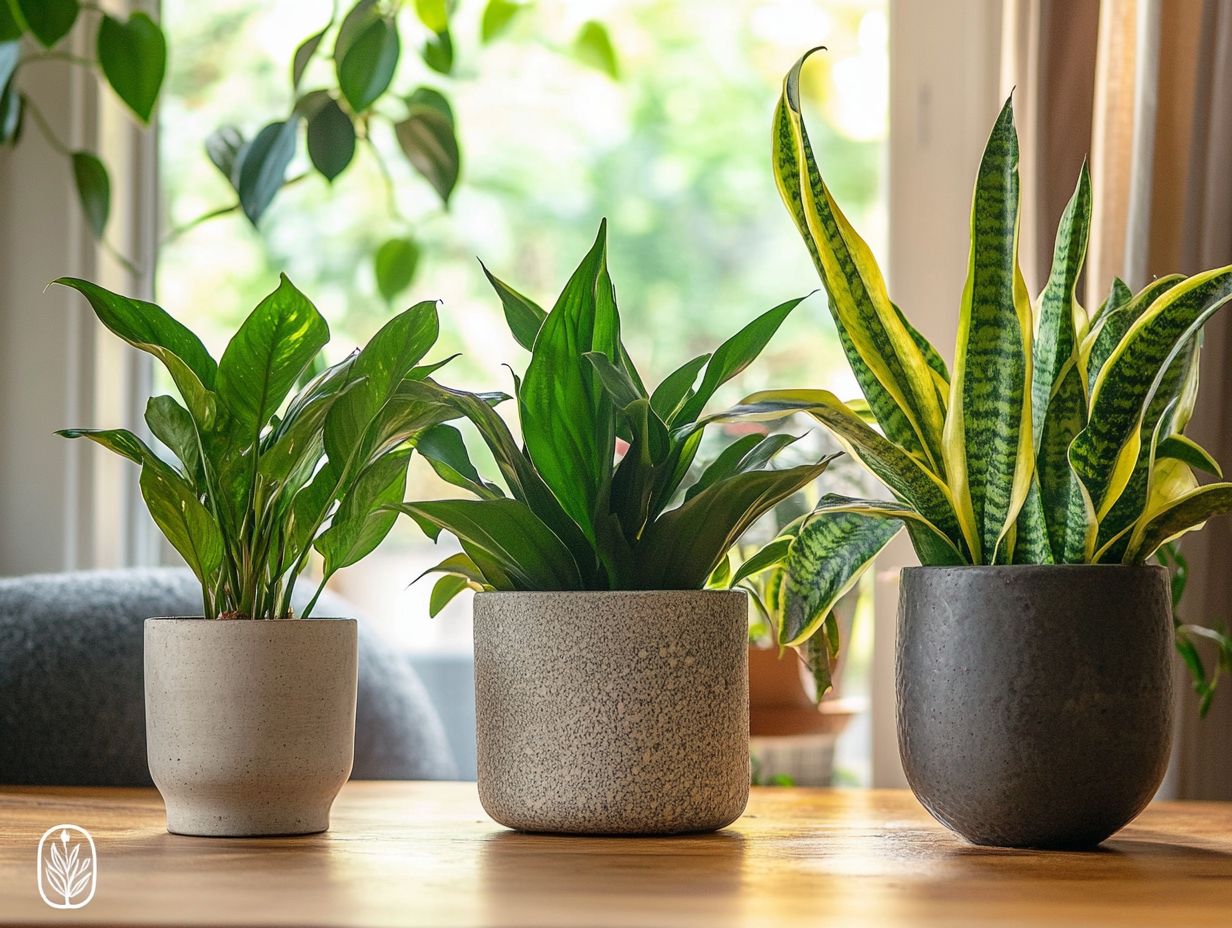
Some common types of low light indoor plants include snake plants, pothos, peace lilies, and philodendrons. These plants are known for their ability to thrive in low light conditions.
How can I determine the lighting conditions in my home?
To determine the lighting conditions in your home, use a light meter or observe the amount of natural light your room receives throughout the day. Rooms with windows facing north or east typically have lower light levels.
What are some low light plants that are safe for pets?
Spider plants, Boston ferns, and African violets are fantastic low light plants that are safe for your furry friends. Always check a plant’s safety before bringing it home!
Other safe plants also thrive in low light conditions, providing you with wonderful options to brighten your space.
Do all low light plants require the same amount of maintenance?
No, not all low light plants need the same level of care. Some require more frequent watering and fertilizing, while others thrive with minimal attention.
Think about your schedule and how much time you can dedicate to plant care when choosing your options.
Can I use artificial light to supplement low light for indoor plants?
You can absolutely use artificial light to help your indoor plants grow! LED grow lights are popular choices that provide essential light alongside natural sunlight.


